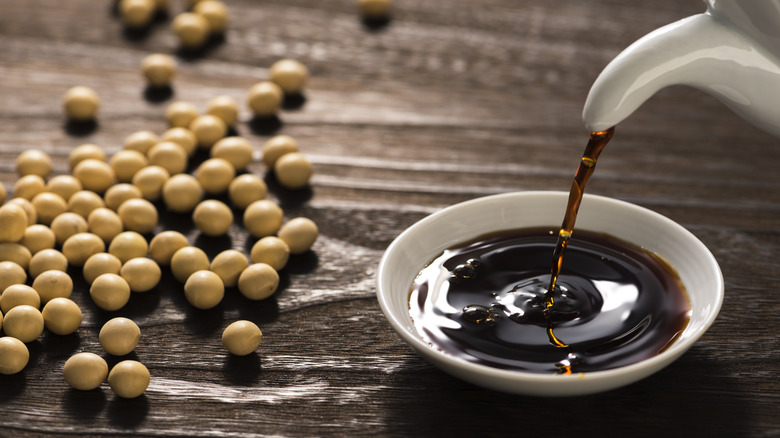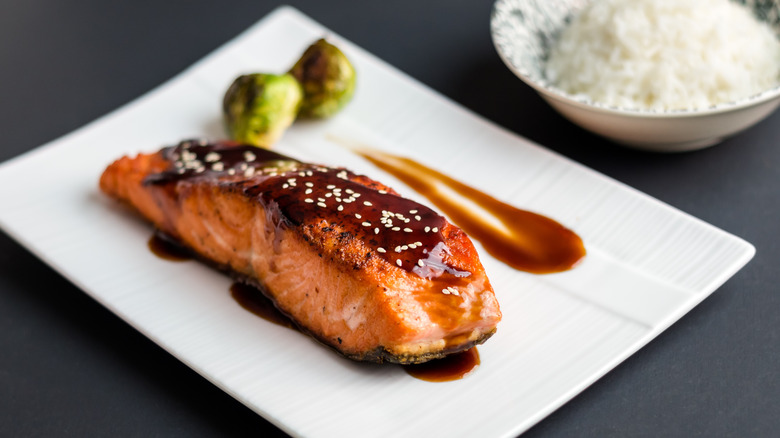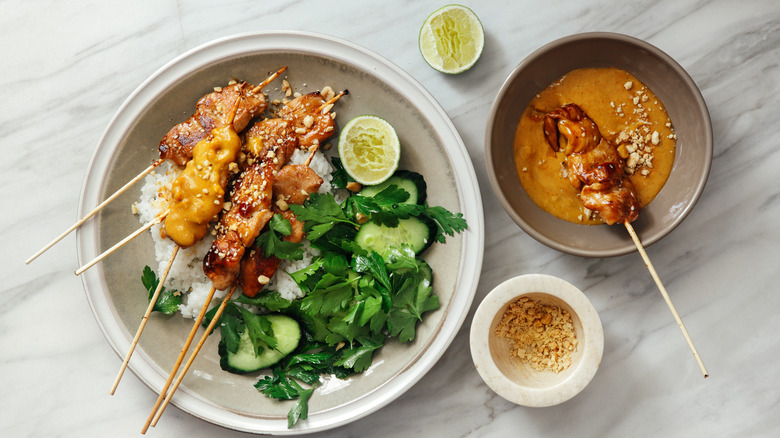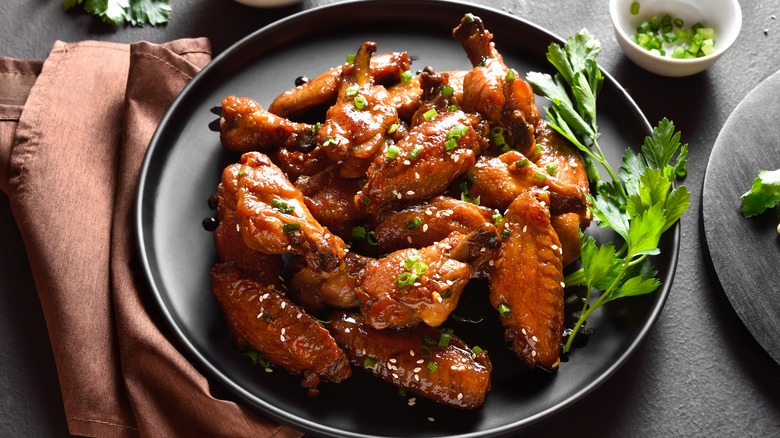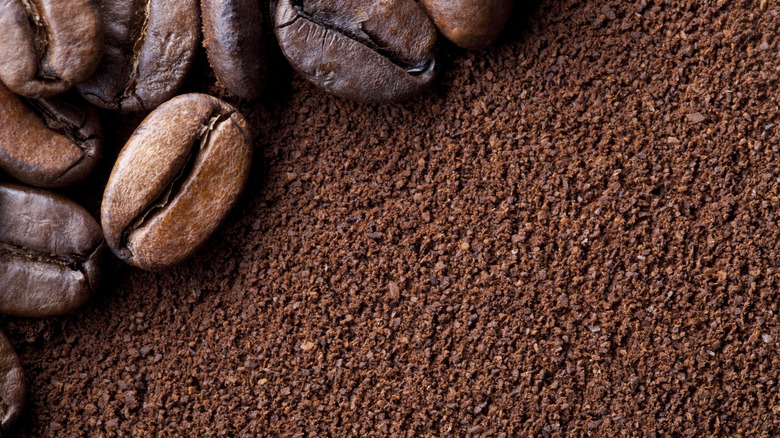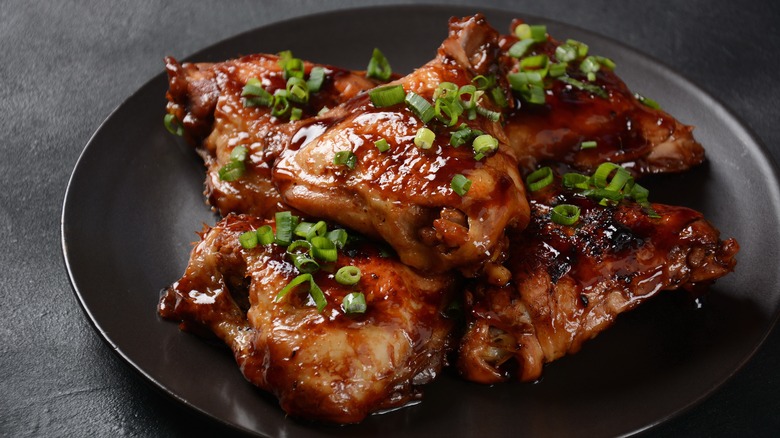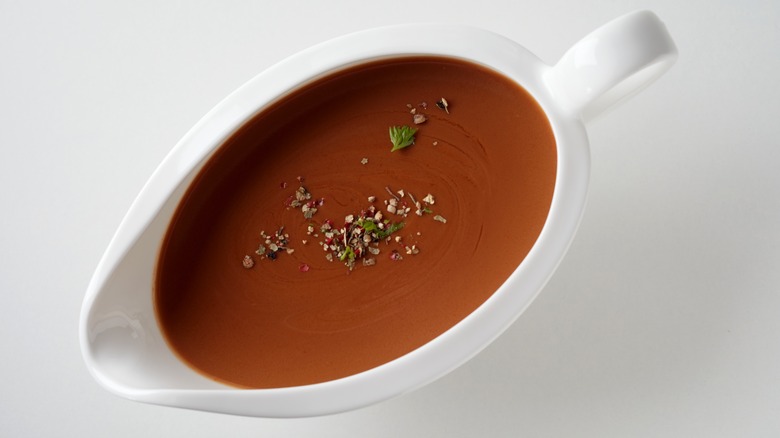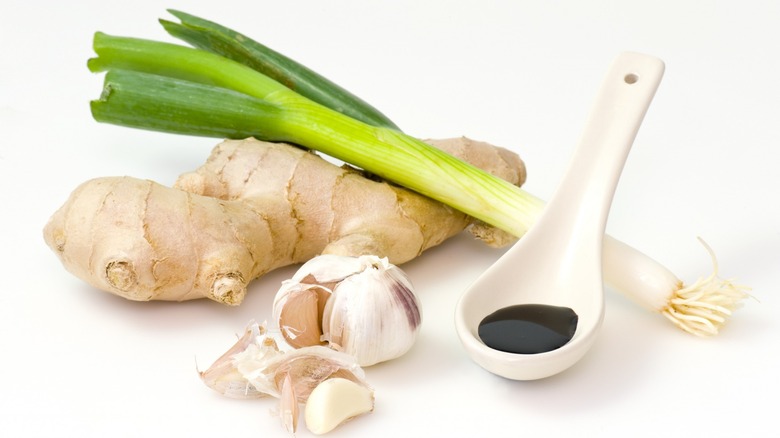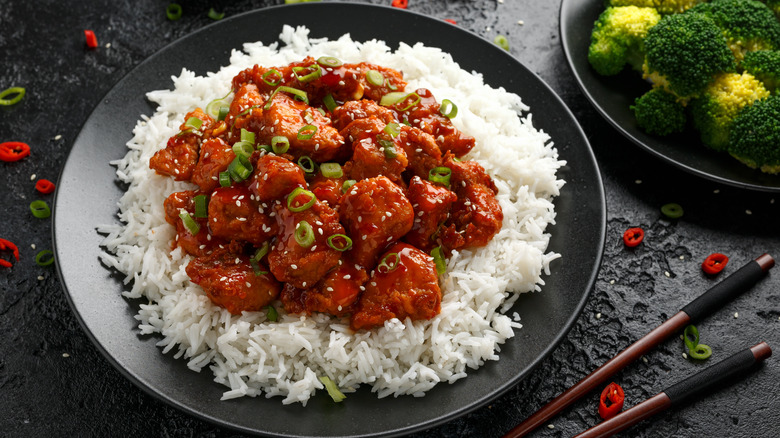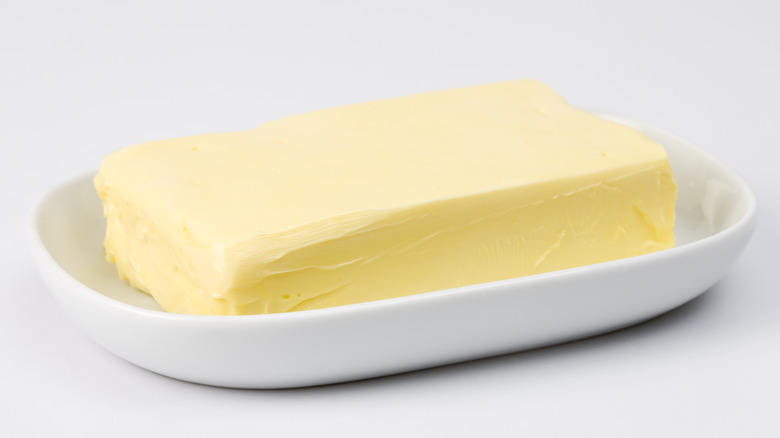10 Delicious Ways To Use Soy Sauce
I always keep a bottle of soy sauce on hand in the kitchen. Affordable yet packed full of umami, a little soy sauce can go a long way. Sometimes, to cut back on the sodium, I'll also use coconut aminos, which are less salty than soy sauce but have a very similar flavor profile. Growing up, I often just put a few splashes on some steamed white rice — but later on, working in kitchens, I came to appreciate just how versatile soy sauce can really be.
Paired with just a few more common ingredients, soy sauce can be easily transformed into glazes, marinades, salad dressings, and more. While there's nothing wrong with keeping it simple and using soy sauce plain straight out of the bottle, a little more time and effort can pay off in spades and take your cooking skills to the next level. If you're looking for a few new ways to boost your game in the kitchen, trying out some simple recipes with soy sauce is a great place to start.
1. Go with a glaze
Soy sauce can be used to make a quick glaze. A glaze is a thickened sauce that's brushed onto a dish at some point during or after the cooking process to add some extra flavor. If there is some amount of sugar in the glaze (as is often the case) it can help caramelize the surface of the food. A good example of this is meatloaf glazed with honey BBQ sauce and baked in the oven. When the sugar in the barbecue sauce heats up in the oven, it sticks to the meatloaf and caramelizes on the surface.
Glazes also work well in stir-fries. You can make a quick glaze to whip up a killer batch of takeout-style orange chicken at home relatively easily with only a handful of ingredients. After mixing soy sauce, sugar, orange juice, honey, ginger, garlic, and a splash of rice vinegar, simmer the sauce until it's thickened into a syrup-like glaze. You can use this citrusy glaze on everything from stir-fried chicken or beef to mixed vegetables or baked tofu. Garnish with chopped green onions and a sprinkle of sesame seeds for a little extra color and flavor.
2. Make some fresh teriyaki sauce
Sweet and savory, teriyaki sauce complements a wide variety of dishes. While it's certainly tempting and convenient to just use a bottle of premade teriyaki sauce from the grocery store, the truth is that it's very easy to make a fresh batch yourself. Not only does homemade teriyaki sauce tend to have a fresher flavor, but making it from scratch also allows you to customize the recipe to your liking. Do you like your teriyaki sauce a little sweeter? Add a little more brown sugar. Do you prefer it with a little sparkle of spice? Stir in some dried chili flakes. Buying premade teriyaki sauce from the store limits its flavor potential, but making teriyaki sauce at home opens a whole new world of possibilities — and it all starts with some soy sauce.
To make some easy teriyaki sauce, combine a half-cup of soy sauce with a quarter-cup of brown sugar in a small saucepan. Add a drizzle of sesame oil, a pinch of grated fresh ginger, a little minced garlic, and a tablespoon of honey, then simmer on low heat. To thicken the sauce, add a little cornstarch slurry (a tablespoon of cornstarch and two tablespoons of water). Try drizzling this teriyaki sauce on salmon, steak, tuna, or grilled chicken.
3. Whip up some peanut sauce
Peanut sauce is another great thing to make with soy sauce. All you need to make some homemade peanut sauce is some soy sauce, peanut butter, coconut milk, and a little brown sugar. You can also add a dash of curry powder and a drizzle of chili garlic sauce for extra flavor.
The beauty of this peanut sauce is that not only is it easy, but it's also quick to make; it only takes about 10 minutes of gentle simmering in a saucepan on the stove. If you prefer your peanut sauce to have a little kick to it, try adding some crushed red pepper flakes or a squirt of sriracha to the sauce. This peanut sauce is great to drizzle over a stir-fry, some grilled chicken, rice bowls, pad thai, vegetables, crispy tofu, or grilled skewers. You can also use it as a salad dressing or put it on lettuce wraps. Bottom line: there are tons of tasty ways to use easy-to-make peanut sauce. Put some of your soy sauce to good use and give this a try.
4. Make some Korean chicken wings
When making chicken wings, it's always tempting to go with classic buffalo — but switching up the flavors and going with a Korean-inspired sauce can be equally rewarding. Korean fried chicken is known for its delectable balance of sweetness and spice, and soy sauce is often a key ingredient in many of the cuisine's marinades, including Korean BBQ wings.
To make Korean chicken wings, it's best to get some gochujang, which is a Korean red pepper paste that's crucial to many of the cuisine's dishes. Thankfully, because Korean food is becoming increasingly popular in the United States, it's getting easier to find gochujang at many grocery stores. Mix soy sauce with gochujang, honey, ground ginger, and a drizzle of sesame oil. The sauce's color should be dark crimson. Note: different brands of gochujang have varying levels of heat. If you like spicy food, try and find a spicy gochujang. If you prefer more mild flavors, get yourself pepper paste that's on the sweeter side. Once the chicken wings are cooked, give them a toss in your sauce and dig in.
5. Create a coffee marinade
When the roasty flavors of strong coffee and a little soy sauce combine to make a marinade for a pot roast, something magical happens. The coffee and soy sauce soak deep into the beef as it slowly simmers, gradually building a depth of flavor that makes a truly delicious and one-of-a-kind pot roast.
This recipe is best prepared in a slow cooker. Start by placing thinly sliced onions at the bottom of the slow cooker — not only will this protect the bottom of the pot roast from burning, but it will also allow the onions to absorb the pot roast's juices. The pot roast will then get topped with soy sauce, coffee, chicken broth, garlic, oregano, black pepper, and a couple of bay leaves. As the pot roast cooks, your kitchen will fill with the hunger-inducing scent of smoky, coffee-flavored beef. Pro tip: when the pot roast is done, use some of the drippings to make gravy and enjoy with some fresh mashed potatoes.
6. Make a batch of chicken adobo
Chicken adobo is Filipino comfort food at its finest. Sticky and garlicky, yet also peppery, salty, and sweet, chicken adobo is a dish that deliciously captures a variety of flavors in a single bite. What's beautiful about this dish is that it takes less than an hour to cook and it's made with common ingredients, yet the payoff tastes surprisingly complex.
Soy sauce, crushed garlic cloves, onions, and whole black peppercorns are the heart and soul of chicken adobo. A little bit of sugar, vinegar, and some bay leaves are also in the mix. The most important thing to remember here is to use chicken thighs in the recipe. Chicken thighs have a higher concentration of fat compared to chicken breasts. This additional fat helps create extra tender chicken adobo that reduces into a rich, flavorful sauce. Paired with some steamed rice and crispy lumpia, this is a feast that truly fills the belly and warms the soul.
7. Add it to gravy
Do you know all those little brown bits left in the pan after searing some steak or chicken? That's all concentrated flavor, and making some gravy with it is a wise decision. All you really need to do is deglaze the pan with some liquid — preferably some stock or a splash of wine, but even some salted water will do. After scraping up all of those little bits in the pan over low heat and whisking them into the sauce, add some flour and butter to help thicken it into a gravy. Finally, a few splashes of soy sauce can bump up the flavor of the gravy big time.
But you certainly don't have to be a meat-eater to whip up a delicious gravy. This brown gravy recipe is vegan-friendly and makes good use of soy sauce's assertive flavor by simmering it with vegetable broth, onion powder, garlic powder, salt, pepper, whole-wheat pastry flour, and nutritional yeast. Having a few gravy recipes always comes in handy — and soy sauce can play a pivotal role in giving your gravies a little boost.
8. Mix up a garlic, soy, and honey salad dressing
Soy sauce can form the base for a lot of tasty salad dressings that are easy to prepare. Of course, it's easy to just grab a bottle of salad dressing at a grocery store, but the truth is that you can often get more bang for your buck by making it at home instead. Plus, homemade salad dressing comes with the benefit of having a fresher flavor compared to that of some mass-produced, overly processed store-bought dressings. All you need to make this garlic, soy, and honey salad dressing is a small blender (or even just a whisk) and a few simple ingredients.
Add low-sodium soy sauce, sesame oil, fresh ginger, rice wine vinegar, garlic, and honey to your blender. Blend until well combined and then store in the refrigerator. Tasty and versatile, this salad dressing pairs nicely with chicken and many types of vegetables, including cucumbers, spinach, arugula, tomatoes, shredded cabbage, red onions, and carrots.
9. Prepare a takeout-style General Tso's chicken
General Tso's chicken is popular for being tangy and sticky, yet also a little bit spicy. The dish is found at most American-style Chinese restaurants and is often topped with green onions and a sprinkling of sesame seeds along with a serving of steamed broccoli. It may seem like a difficult dish to make at home, but in reality, it's quite easy — and it all comes down to the sauce.
To make General Tso's chicken, marinate cubes of chicken with soy sauce, black pepper, cooking sherry, and egg whites. To make the glaze, mix soy sauce, chicken stock, tomato paste, rice vinegar, hoisin sauce, chili paste, sugar, vegetable oil, and cornstarch. After dipping the chicken into the cornstarch, fry the chicken in a hot pan until crispy and cooked through, then add minced garlic and the prepared glaze. Add some chili flakes if you'd like to make it a little spicy. Once the glaze has thickened and coated all of the chicken, it's chow time.
10. Add it to butter
Creamy and viscous, butter is the perfect vessel to infuse tons of flavor into a wide range of different recipes. Of course, you can always whip up a compound butter — but that will require having other ingredients like garlic, herbs, and spices. If you're looking for a simple way to jazz up some unsalted butter, you can add a few drops to some softened butter and stir it. The soy sauce will give the butter a nice pop of umami that's bound to make anything it touches more tasty.
Once your soy butter is mixed, you can use it for tons of different foods. Try brushing it onto grilled steak, steamed broccoli, or roasted brussel sprouts. Looking for a quick snack for a movie night at home? Bust out the soy butter and drizzle it over a fresh batch of hot popcorn. For more complexity, try browning the butter first, then adding a little fresh lemon juice into the mix.
